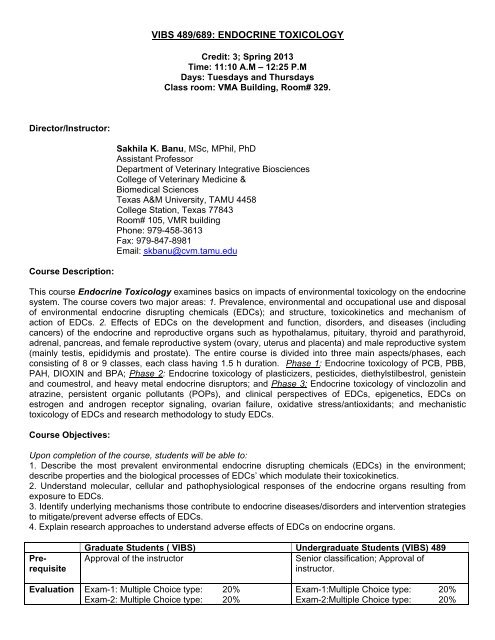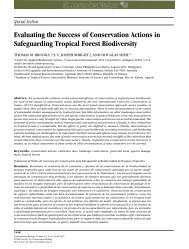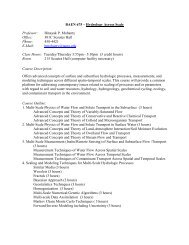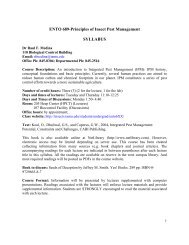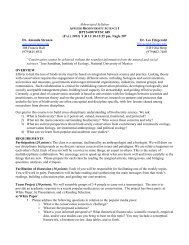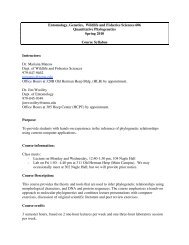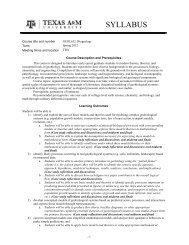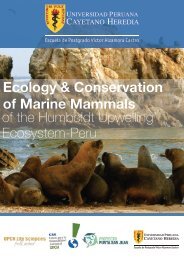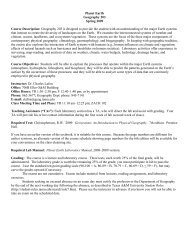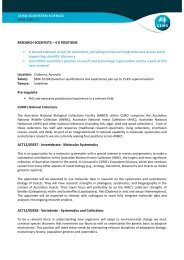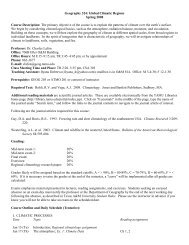endocrine toxicology - Ecology and Evolutionary Biology - Texas ...
endocrine toxicology - Ecology and Evolutionary Biology - Texas ...
endocrine toxicology - Ecology and Evolutionary Biology - Texas ...
Create successful ePaper yourself
Turn your PDF publications into a flip-book with our unique Google optimized e-Paper software.
Director/Instructor:<br />
Course Description:<br />
VIBS 489/689: ENDOCRINE TOXICOLOGY<br />
Credit: 3; Spring 2013<br />
Time: 11:10 A.M – 12:25 P.M<br />
Days: Tuesdays <strong>and</strong> Thursdays<br />
Class room: VMA Building, Room# 329.<br />
Sakhila K. Banu, MSc, MPhil, PhD<br />
Assistant Professor<br />
Department of Veterinary Integrative Biosciences<br />
College of Veterinary Medicine &<br />
Biomedical Sciences<br />
<strong>Texas</strong> A&M University, TAMU 4458<br />
College Station, <strong>Texas</strong> 77843<br />
Room# 105, VMR building<br />
Phone: 979-458-3613<br />
Fax: 979-847-8981<br />
Email: skbanu@cvm.tamu.edu<br />
This course Endocrine Toxicology examines basics on impacts of environmental <strong>toxicology</strong> on the <strong>endocrine</strong><br />
system. The course covers two major areas: 1. Prevalence, environmental <strong>and</strong> occupational use <strong>and</strong> disposal<br />
of environmental <strong>endocrine</strong> disrupting chemicals (EDCs); <strong>and</strong> structure, toxicokinetics <strong>and</strong> mechanism of<br />
action of EDCs. 2. Effects of EDCs on the development <strong>and</strong> function, disorders, <strong>and</strong> diseases (including<br />
cancers) of the <strong>endocrine</strong> <strong>and</strong> reproductive organs such as hypothalamus, pituitary, thyroid <strong>and</strong> parathyroid,<br />
adrenal, pancreas, <strong>and</strong> female reproductive system (ovary, uterus <strong>and</strong> placenta) <strong>and</strong> male reproductive system<br />
(mainly testis, epididymis <strong>and</strong> prostate). The entire course is divided into three main aspects/phases, each<br />
consisting of 8 or 9 classes, each class having 1.5 h duration. Phase 1: Endocrine <strong>toxicology</strong> of PCB, PBB,<br />
PAH, DIOXIN <strong>and</strong> BPA; Phase 2: Endocrine <strong>toxicology</strong> of plasticizers, pesticides, diethylstilbestrol, genistein<br />
<strong>and</strong> coumestrol, <strong>and</strong> heavy metal <strong>endocrine</strong> disruptors; <strong>and</strong> Phase 3: Endocrine <strong>toxicology</strong> of vinclozolin <strong>and</strong><br />
atrazine, persistent organic pollutants (POPs), <strong>and</strong> clinical perspectives of EDCs, epigenetics, EDCs on<br />
estrogen <strong>and</strong> <strong>and</strong>rogen receptor signaling, ovarian failure, oxidative stress/antioxidants; <strong>and</strong> mechanistic<br />
<strong>toxicology</strong> of EDCs <strong>and</strong> research methodology to study EDCs.<br />
Course Objectives:<br />
Upon completion of the course, students will be able to:<br />
1. Describe the most prevalent environmental <strong>endocrine</strong> disrupting chemicals (EDCs) in the environment;<br />
describe properties <strong>and</strong> the biological processes of EDCs’ which modulate their toxicokinetics.<br />
2. Underst<strong>and</strong> molecular, cellular <strong>and</strong> pathophysiological responses of the <strong>endocrine</strong> organs resulting from<br />
exposure to EDCs.<br />
3. Identify underlying mechanisms those contribute to <strong>endocrine</strong> diseases/disorders <strong>and</strong> intervention strategies<br />
to mitigate/prevent adverse effects of EDCs.<br />
4. Explain research approaches to underst<strong>and</strong> adverse effects of EDCs on <strong>endocrine</strong> organs.<br />
Prerequisite<br />
Evaluation<br />
Graduate Students ( VIBS) Undergraduate Students (VIBS) 489<br />
Approval of the instructor Senior classification; Approval of<br />
instructor.<br />
Exam-1: Multiple Choice type: 20%<br />
Exam-2: Multiple Choice type: 20%<br />
Exam-1:Multiple Choice type: 20%<br />
Exam-2:Multiple Choice type: 20%
Grading<br />
Study<br />
Materials:<br />
Exam-3: Multiple Choice type: 20%<br />
Exam-4: Case study report *: 40%<br />
Total: 100%<br />
* Case Study Report: All students will be required<br />
to prepare a case study report (maximum total of<br />
10 pages, 2.0 line spaced; 1 inch margins; 12 pt<br />
Arial or Times Roman font; 10 references<br />
minimum). The case study will require examining a<br />
chemical in a specific contaminated site (e.g.,<br />
chromium in California <strong>and</strong> New Jersey) or a<br />
chemical that affects a more specific target<br />
<strong>endocrine</strong> organ (e.g., organochlorine <strong>and</strong> thyroid<br />
gl<strong>and</strong> or dioxin <strong>and</strong> endometriosis), or choose one<br />
of the “World’s worst polluted places”, <strong>and</strong> select<br />
one particular EDC <strong>and</strong> its clinical /endocrinological<br />
relevance on the health of the people living in that<br />
environment. Alternatively, choose an EDC that is<br />
more relevant to occupational exposure etc., (the<br />
student can obtain help from the instructor to<br />
choose the topic). The case study will examine<br />
sources, pathways, transport, levels of<br />
contamination in the environment, remediation<br />
process (if any), <strong>and</strong> receptors in the target<br />
<strong>endocrine</strong> organ, <strong>and</strong> end-point diseases or<br />
disorders. The paper should be submitted<br />
according to a required format <strong>and</strong> will reference<br />
peer‐reviewed work <strong>and</strong> reviews, website<br />
information, reports from USEPA <strong>and</strong>/or ATSDR,<br />
The Blacksmith Institute etc.<br />
90-100 : A<br />
80-89.99 : B<br />
70-79.99 : C<br />
60-69.99 : D<br />
Less than 60 : F<br />
H<strong>and</strong> out of the lecture will be given (Most of the<br />
objective questions will be taken from lectures).<br />
Particular book chapters or interested journals<br />
could be referred.<br />
Course material will be derived from the<br />
following books & reviews.<br />
1. Casarett & Doull's Essentials of Toxicology, by<br />
Curtis D. Klaassen <strong>and</strong> John B. Watkins III.<br />
2. Endocrine Toxicology, Third Edition, by J.<br />
Charles Eldridge <strong>and</strong> James T. Stevens.<br />
3. Our Stolen Future by<br />
Theo Colborn, Dianne Dumanoski, John Peterson<br />
Myers, published by Dutton.<br />
4. Environmental Endocrine Disrupters: An<br />
<strong>Evolutionary</strong> Perspective, by A Crain, L J Guillette<br />
Jr., published by Taylor & Francis.<br />
5. Endocrine Disrupting Chemicals: An Endocrine<br />
Exam-3:Multiple Choice type: 20%<br />
Exam-4:Descriptive (short essays)* 40%<br />
Total: 100%<br />
Students will be asked essay<br />
questions, <strong>and</strong> should be answered in<br />
the given page limit. Exams 1, 2 & 3<br />
are class room exams <strong>and</strong> exam 4 is a<br />
take home assignment.<br />
Case study report not required.<br />
90-100 : A<br />
80-89.99 : B<br />
70-79.99 : C<br />
60-69.99 : D<br />
Less than 60 : F<br />
H<strong>and</strong> out of the lecture will be given (most<br />
of the questions will be taken from<br />
lectures). Particular book chapters or<br />
interested journals could be referred.<br />
Course material will be derived from<br />
the following books & reviews.<br />
1. Casarett & Doull's Essentials of<br />
Toxicology, by Curtis D. Klaassen <strong>and</strong><br />
John B. Watkins III.<br />
2. Endocrine Toxicology, Third Edition, by<br />
J. Charles Eldridge <strong>and</strong> James T.<br />
Stevens.<br />
3. Our Stolen Future by<br />
Theo Colborn, Dianne Dumanoski, John<br />
Peterson Myers, published by Dutton.<br />
4. Environmental Endocrine Disrupters:
Society Scientific Statement. Endocrine Reviews:<br />
2009: 30: 293-342.<br />
6. In utero effects of chemicals on reproductive<br />
tissues in females. Miller KP et al.,<br />
Toxicol Appl Pharmacol. 2004; 198:111-31.<br />
Review.<br />
7. Reproductive Toxicology, 3rd Edition, R W kapp,<br />
R W Tyl, CRC Press, 2009.<br />
8. Endocrine Disruptors: Part 1, H G (CONN) Dorr,<br />
Springer, 2001<br />
Americans with Disabilities Act (ADA) Policy Statement<br />
An <strong>Evolutionary</strong> Perspective, by A Crain,<br />
L J Guillette Jr., published by Taylor &<br />
Francis.<br />
5. Endocrine Disrupting Chemicals: An<br />
Endocrine Society Scientific Statement.<br />
Endocrine Reviews: 2009: 30: 293-342.<br />
6. In utero effects of chemicals on<br />
reproductive tissues in females. Miller KP<br />
et al.,<br />
Toxicol Appl Pharmacol. 2004; 198:111-<br />
31. Review.<br />
7. Reproductive Toxicology, 3rd Edition,<br />
R W kapp, R W Tyl, CRC Press, 2009.<br />
8. Endocrine Disruptors: Part 1, H G<br />
(CONN) Dorr, Springer, 2001<br />
The Americans with Disabilities Act (ADA) is a federal anti-discrimination statute that provides comprehensive<br />
civil rights protection for persons with disabilities. Among other things, this legislation requires that all students<br />
with disabilities be guaranteed a learning environment that provides for reasonable accommodation of their<br />
disabilities. If you believe you have a disability requiring an accommodation, please contact the Department of<br />
Student Life, Services for Students with Disabilities, in Cain Hall or call 845-1637.<br />
Academic Integrity Statement<br />
“An Aggie does not lie, cheat, or steal or tolerate those who do.”<br />
The student to the Honor Council Rules <strong>and</strong> Procedures can be found on the web<br />
http://www.tamu.edu/aggiehonor<br />
Lec# Day &<br />
Time<br />
1<br />
2<br />
3<br />
4<br />
5<br />
Tuesday<br />
2.20-3.35<br />
PM<br />
Thursday<br />
2.20-3.35<br />
PM<br />
Tuesday<br />
2.20-<br />
3.35PM<br />
Thursday<br />
2.20-3.35<br />
PM<br />
Tuesday<br />
2.20-3.35<br />
PM<br />
Thursday<br />
6<br />
2.20-3.35<br />
PM<br />
7 Tuesday<br />
2.20-3.35<br />
Title/Topic<br />
DATE<br />
Phase I- EDCs – PCB, PBB, PAH, DIOXIN & BPA.<br />
1/15 An Overview on the Industrial Revolution, Endocrine Disruptors, Irreversible<br />
Contamination of Drinking Water <strong>and</strong> Their Impact on Endocrine Diseases<br />
<strong>and</strong> Disorders in the Human.<br />
1/17<br />
Influence of EDCs on Learning <strong>and</strong> Memory, <strong>and</strong> Their Effects on<br />
Neurocognitive Disorders.<br />
1/22 Introduction to Environmental Endocrine Disrupting Chemicals (EDC).<br />
1/24 Structure <strong>and</strong> Toxicokinetics of Polychlorinated biphenyls (PCBs),<br />
Polybrominated Biphenyls (PBBs) & Polycyclic Aromatic Hydrocarbons<br />
(PAH); <strong>and</strong> Their Effects on Hypothalamo-Pituitary-Thyroid (HPT) Axis.<br />
1/29<br />
Effects of PCBs <strong>and</strong> PBBs on Male <strong>and</strong> Female Reproductive System.<br />
1/31 Effects of PCBs, PBBs <strong>and</strong> PAHs on Mammary Gl<strong>and</strong> Development <strong>and</strong><br />
Cancers.<br />
2/5 Structure <strong>and</strong> Toxicokinetics of Dioxins & Bisphenol A (BPA); <strong>and</strong> Their<br />
Effects on Male <strong>and</strong> Female Reproduction, <strong>and</strong> Fetal Development.
8<br />
9<br />
10<br />
11<br />
12<br />
13<br />
14<br />
15<br />
16<br />
17<br />
18<br />
19<br />
PM<br />
T7hursday<br />
2.20-3.35<br />
PM<br />
Tuesday<br />
2.20-3.35<br />
PM<br />
Thursday<br />
2.20-3.35<br />
PM<br />
2/7<br />
2/12<br />
2/14<br />
Happy<br />
Valentine<br />
Endocrine Disruptors <strong>and</strong> Endometriosis.<br />
REVIEW AND DISCUSSION - 1<br />
EXAM - 1<br />
Phase II: Plasticizers, pesticides, diethylstilbestrol, genistein <strong>and</strong> coumestrol, bioremediation<br />
of EDCs, <strong>and</strong> heavy metal <strong>endocrine</strong> disruptors.<br />
Tuesday 2/19 Structure <strong>and</strong> Toxicokinetics of Plasticizers Phthalates; <strong>and</strong> Reproductive <strong>and</strong><br />
2.20-3.35<br />
PM<br />
Developmental Toxicity of Phthalates.<br />
Thursday<br />
2.20-3.35<br />
PM<br />
2/21<br />
Effects of Pesticides [methoxychlor, chlorpyrifos, <strong>and</strong><br />
dichlorodiphenyltrichloroethane (DDT)] on Neuro<strong>endocrine</strong> System.<br />
Tuesday 2/26 Endocrine Disruption of Diethylstilbestrol (DES) – I<br />
2.20-3.35<br />
[Effects on Male <strong>and</strong> Female Reproductive Toxicity & Developmental<br />
PM<br />
Toxicity].<br />
Thursday 2/28 Overview of Endocrine Disruption <strong>and</strong> Reproductive Health from a Clinical<br />
2.20-3.35<br />
PM<br />
Perspective.<br />
Tuesday 3/5 Endocrine Disruption of Phytoestrogens Genistein <strong>and</strong> Coumestrol.<br />
2.20-3.35<br />
PM<br />
Bioremediation of EDCs.<br />
Thursday<br />
2.20-3.35<br />
PM<br />
3/7 Heavy Metal Toxicity & Endocrine Disruption<br />
3/12 – 3/16 SPRING BREAK<br />
Tuesday 3/19<br />
2.20-3.35<br />
PM<br />
REVIEW AND DISCUSSION - 2<br />
Thursday 3/21<br />
2.20-3.35<br />
PM<br />
EXAM - 2<br />
Phase III: Vinclozolin <strong>and</strong> atrazine, Persistent Organic Pollutants (POPs), Clinical perspectives,<br />
Epigeenetics <strong>and</strong> ER-signaling <strong>and</strong> EDCs, ovarian failure, oxidative stress/antioxidants <strong>and</strong><br />
EDCs; <strong>and</strong> mechanistic <strong>toxicology</strong> <strong>and</strong> research methodology to study EDCs.<br />
Tuesday<br />
2.20-3.35<br />
PM<br />
3/26 Endocrine disruption of fungicides (vinclozolin).<br />
Thursday<br />
2.20-3.35<br />
PM<br />
3/28 Endocrine Disruption of Herbicides (atrazine).<br />
Tuesday<br />
2.20-3.35<br />
PM<br />
4/2 Epigenetics <strong>and</strong> Environmental Endocrine Disruptors.<br />
Thursday<br />
2.20-3.35<br />
PM<br />
4/4 Endocrine Disruptor Interaction with Steroid Receptors.<br />
Tuesday<br />
2.20-3.35<br />
4/9 Occupational <strong>and</strong> Environmental Exposure to EDCs <strong>and</strong> Ovarian Failure.
20<br />
21<br />
PM<br />
Thursday<br />
2.20-3.35<br />
PM<br />
Tuesday<br />
2.20-3.35<br />
PM<br />
Thursday<br />
2.20-3.35<br />
PM<br />
Tuesday<br />
2.20-3.35<br />
PM<br />
4/11 The Roles of Oxidative Stress in Endocrine Disruption.<br />
4/16 (i) In vivo <strong>and</strong> In vitro Research Approaches to Underst<strong>and</strong> the Basic<br />
Mechanisms of Endocrine Disruption.<br />
(ii) Policies <strong>and</strong> Regulations of EDCs.<br />
4/18<br />
REVIEW AND DISCUSSION - 3<br />
4/25<br />
5/7 Last date for submitting<br />
assignments/case reports.<br />
EXAM - 3<br />
Return the case study report <strong>and</strong> assignment to Dr. Banu<br />
Email: skbanu@cvm.tamu.edu


